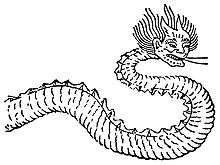Gonggong
Gonggong /ˈɡɒŋɡɒŋ/ is a Chinese water god who is depicted in Chinese mythology and folktales as having a copper human head with an iron forehead, red hair, and the body of a serpent or a human head and torso with the tail of a serpent.[1][2] He is destructive and is blamed for various cosmic catastrophes. In all accounts, Gonggong ends up being killed or sent into exile, usually after losing a struggle with another major deity such as the fire god Zhurong.
| Gonggong | |||||||||||||||||||||||
|---|---|---|---|---|---|---|---|---|---|---|---|---|---|---|---|---|---|---|---|---|---|---|---|
 A human-headed serpent similar to depictions of Gonggong. Some images of Gonggong depict the torso as also human. (See 'external links' below for a © illustration of the actual Gonggong.) | |||||||||||||||||||||||
| Chinese name | |||||||||||||||||||||||
| Chinese | 共工 | ||||||||||||||||||||||
| |||||||||||||||||||||||
| Gōnggōng | |||||||||||||||||||||||
| Traditional Chinese | 龔工 | ||||||||||||||||||||||
| Simplified Chinese | 龚工 | ||||||||||||||||||||||
| |||||||||||||||||||||||
| Kanghui | |||||||||||||||||||||||
| Chinese | 康回 | ||||||||||||||||||||||
| |||||||||||||||||||||||
| Japanese name | |||||||||||||||||||||||
| Kanji | 共工 | ||||||||||||||||||||||
| Hiragana | きょうこう | ||||||||||||||||||||||
| |||||||||||||||||||||||
In astronomy, the planetoid 225088 Gonggong is named after Gonggong.
Name
In English the two syllables of the name are the same, but in Mandarin they differ in tone (共工 Gònggōng), and in other Chinese languages they differ in their vowel and the initial consonant as well (cf. Middle Chinese *ɡɨoŋh-kuŋ, also Japanese kyōkō). The most common variant of the name, 龔工, is identical to the first in English, but in Mandarin differs in tone (Gōnggōng), and in other Chinese languages in consonant and vowel as well (cf. Middle Chinese *kɨoŋ-kuŋ).
Gonggong's personal name is said to be Kanghui (pronounced either /ˈkæŋhuːi/ KANG-hoo-ee in English, or as Mandarin Kānghuí – approximately /kɒŋˈhweɪ/ kong-HWAY).
Legend
Gonggong is known from the late Warring States period (before 221 BCE). Gonggong appears in the ancient "Heavenly Questions" (Tianwen) poem of the Chu Ci, where he is blamed for knocking the earth's axis off center, causing it to tilt to the southeast and the sky to tilt to the northwest.[2] This axial tilt is used to explain why the rivers of China generally flow to the southeast, especially the Yangzi River and the Yellow River, and why the sun, moon, and stars move towards the northwest. Literature from the Han dynasty becomes much more detailed regarding Gonggong.
Gonggong was credited in various mythological contexts as being responsible for great floods, often in concert with his minister Xiangliu (a.k.a. Xiangyao), who has nine heads and the body of a snake.
Gonggong was ashamed that he lost the fight with Zhurong, the Chinese god of fire, to claim the throne of Heaven. In a fit of rage he smashed his head against Buzhou Mountain, one of eight pillars holding up the sky, greatly damaging it and causing the sky to tilt towards the northwest and the earth to shift to the southeast, which caused great floods and suffering.
The goddess Nüwa cut off the legs of the giant turtle Ao and used them in place of the fallen pillar, ending the floods and suffering; she was, however, unable to fully correct the tilted sky and earth and alter their effects on the sun, moon, stars, and rivers in China.
See also
- Yinglong
- Four Evildoers
References
Citations
- ChineseWords.org
- Yang & al. (2005), p. 124.
Bibliography
- Yang Lihui & al. (2005), Handbook of Chinese Mythology, Oxford: Oxford University Press, ISBN 978-0-19-533263-6
External links
- Book cover with (copyrighted) image of Gonggong
- second image
- Gong Gong 共工 at ChinaKnowledge.de: An Encyclopaedia on Chinese History, Literature and Art